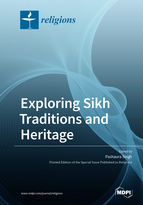Exploring Sikh Traditions and Heritage
A special issue of Religions (ISSN 2077-1444).
Deadline for manuscript submissions: closed (31 October 2020) | Viewed by 36970
Special Issue Editor
Special Issue Information
Dear Colleagues,
This Special issue will publish articles on a broad theme of "Exploring Sikh Traditions and Heritage.” Notably, the early twenty-first century continues to be a very exciting time for the field of Sikh studies. Within the last two decades, scholars have begun to question prevailing approaches to the study of Sikhism in both the west and India itself to the point that this least-examined and perhaps most misunderstood of South Asia’s religious and cultural traditions is now an established part of curricula and scholarly programs across North America and the United Kingdom.
Much of the foundational scholarship in the field of Sikh studies has followed historical and textual approaches, sometimes to the extent of softening the focus on Sikh practices, performances, and everyday ‘doings’ of Sikh lives. The growing turn in religious studies toward ‘lived religion’ calls scholars to be aware that ‘religions’ are at least as much about the things that people ‘do’ as about the ideas, ideals, and central narratives enshrined within their texts and scripture. Rather than dichotomize text and practice, we invite papers that draw attention to the intersections between Sikh sacred texts and actual practices of the Sikh community.
In this Special Issue, we provide the opportunity to explore Sikh traditions and heritage through interdisciplinary approaches, resulting from academic inquiries into Sikh texts, as well as the practices that surround them and their performance. For this purpose, we encourage a diverse range of theoretical and methodological approaches, including religious studies, historical studies, textual studies, musicology, anthropology, political science, sociology, philosophy, ethnography, art and material culture, and ritual and performance studies.
The purpose of this Special Issue is to enhance the field of Sikh studies and to contribute in the production of novel research. It will usefully supplement (relate to) existing literature in the field. Thus, we invite both younger scholars following fresh approaches and established scholars who have already made significant contributions to the study of Sikh traditions and heritage.
Prof. Dr. Pashaura Singh
Guest Editor
Manuscript Submission Information
Manuscripts should be submitted online at www.mdpi.com by registering and logging in to this website. Once you are registered, click here to go to the submission form. Manuscripts can be submitted until the deadline. All submissions that pass pre-check are peer-reviewed. Accepted papers will be published continuously in the journal (as soon as accepted) and will be listed together on the special issue website. Research articles, review articles as well as short communications are invited. For planned papers, a title and short abstract (about 100 words) can be sent to the Editorial Office for announcement on this website.
Submitted manuscripts should not have been published previously, nor be under consideration for publication elsewhere (except conference proceedings papers). All manuscripts are thoroughly refereed through a double-blind peer-review process. A guide for authors and other relevant information for submission of manuscripts is available on the Instructions for Authors page. Religions is an international peer-reviewed open access monthly journal published by MDPI.
Please visit the Instructions for Authors page before submitting a manuscript. The Article Processing Charge (APC) for publication in this open access journal is 1800 CHF (Swiss Francs). Submitted papers should be well formatted and use good English. Authors may use MDPI's English editing service prior to publication or during author revisions.






